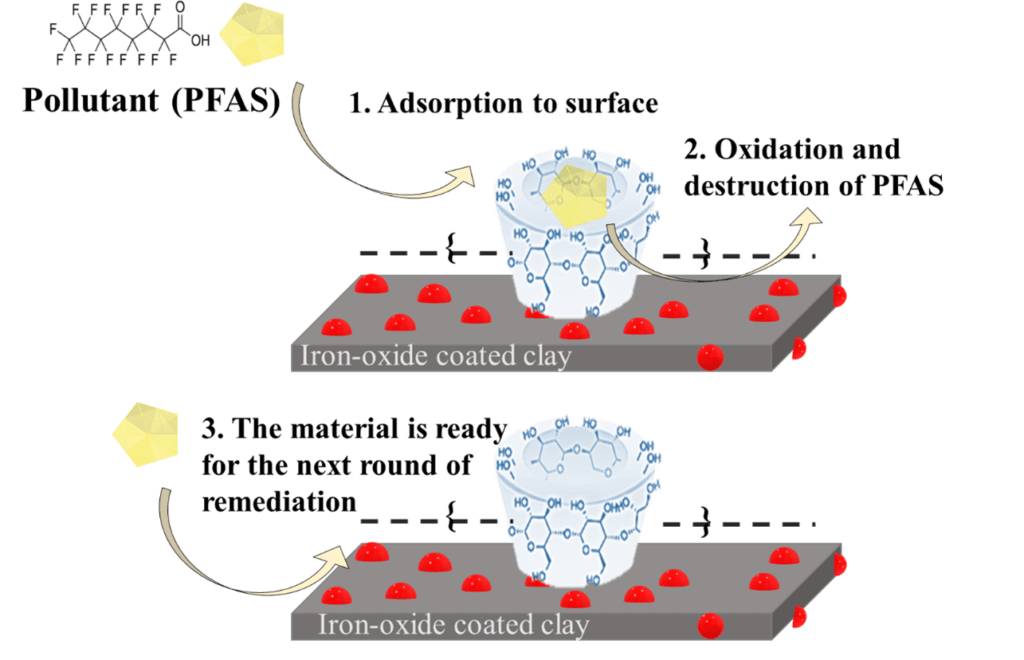Researchers from the Technion – Israel Institute of Technology have developed innovative technology to remove dangerous pollutants from drinking water.
The technology efficiently removes and destroys synthetic organofluorine chemical compounds (PFAS). PFAS is a family of problematic pollutants, also known as “forever chemicals” because of their chemical stability and environmental persistence.
There are thousands of PFAS chemicals, and they are found in many different consumer, commercial, and industrial products. This makes it challenging to study and assess the potential human health and environmental risks. These substances can be found in air, water, soil, and food, as well as a large range of products, including Teflon pan coating, fire-fighting foam, flame retardants, and water repellent additives. They reach the groundwater in various ways, including agricultural irrigation using treated wastewater and fire-fighting substances seeping into the soil. As a result of their chemical stability, they remain intact in the ground for a long time, leading to extensive contamination of drinking sources, which in turn significantly increases human exposure.

“Lately, it has become clear that these chemicals are of severe health and ecological hazard – thus, finding ways to remove and destroy them is of great importance,” Dr. Adi Radian, an assistant professor at the Technion, tells NoCamels.
Dr. Radian, head of the Soil and Environmental Chemistry Lab in the Department of Civil and Environmental Engineering, headed the study with her post-doctoral student Dr. Samapti Kundu. Their findings were published in the Chemical Engineering Journal.

Exposure to PFAS can cause many health risks, including cancer, heart, and liver disease, fertility problems, birth defects, and damage to the immune system. In 2017, the International Agency for Research on Cancer (IARC) classified polyfluoroalkyl substance (PFAS), as a possible human carcinogen based in part on limited epidemiologic evidence of associations with cancers of the kidney and testis in heavily exposed subjects.
These substances have been monitored in Israel. Last summer, the Israel Fire and Rescue Authority stopped using fire retardant foam containing two toxic substances from the PFAS family out of concern that these chemicals would seep into the groundwater, Israeli daily newspaper Haaretz reported. A few months prior, the Health Ministry had discovered a drinking water source that had been polluted by these chemicals located in the Haifa Bay suburbs. They assumed that the pollution comes from the use of this fire-retardant foam at a fuel storage facility in the area. The extraction of potable water in the Krayiot region was stopped following the discovery of this high PFAS concentration.
SEE ALSO: This Modern Day Miriam’s Well Will Provide Clean Water For The Masses
Haaretz reported that there are currently no standards in Israel for the maximum allowable concentration of PFAS in drinking water, but that the Standards Institution is formulating a standard for firefighting foam that will also include toxicity levels, including a ban on the use of two PFAS compounds and a restriction on the concentration of another.
In the present day, the removal of these substances from drinking water happens through relatively simple and inexpensive adsorption techniques. (Adsorption is the adhesion of atoms, ions or molecules from a gas, liquid or dissolved solid to a surface. This process creates a film of the adsorbate on the surface of the adsorbent. This process differs from absorption, in which a fluid – the absorbate – is dissolved by or permeates a liquid or solid – the absorbent). These methods are not sufficiently efficient and only transfer the pollutants from the water to the adsorbent material – which requires additional purification steps to get rid of the toxic adsorbed substances. Also, these methods are not selective. They can also potentially remove substances that are essential to a person’s health.
Sign up for our free weekly newsletter
SubscribeThe findings
The new research examined the possibility of combining the two methods – separating the pollutants with special polymers and then using advanced oxidation processes to eliminate them. The findings indicate that proper planning leads to high efficiency under a wide range of acidity (pH) and salinity.

The method depicted in the study shows the removal of seven types of PFAS – even when all of them are found in the same unit of fluid – at a level of efficiency that approaches 90 percent, and it does so within a few minutes.
“Our proposed platform has two benefits,” Dr. Radian explains, “First, it acts as a sorbent – removing PFAS
rapidly and efficiently from source contaminated waters. Once the filter has reached capacity, we can regenerate it easily by adding hydrogen peroxide, which breaks down the adsorbed contaminants and refreshes the sorbent for continuous use.”
Another great advantage of the method, Dr. Radian says, is that adsorbent material is based on clay, iron oxides, and cyclodextrins – all non-toxic, sustainable materials that can be easily disposed of once they are no longer needed.
The clay-iron-polymer composites act as accelerators that confine the PFAS on the surface and then accelerate the oxidation process that destroys the pollutants into non-toxic substances (fluoride ions, water, and carbon dioxide). This combination efficiently removes the PFAS and does not release unwanted substances in water used for drinking.
The researchers show that this system makes it unnecessary to carry out complementary processes such as heating, UV radiation, and using sound waves, which make the task more complicated and more expensive.
The future
Dr. Radian says that the platform has been validated with a variety of toxic pollutants, not just PFAS. “We are hoping to upscale the technology in the coming year and test it with real water from contaminated sites in Israel. I am hopeful that this technology will mature into an applied, sustainable product.”
“I believe that basic scientific and engineering studies, like what is pursued in our department, are the building blocks for applicable technologies in the field,” Dr. Radian tells NoCamels, “Strengthening the ties between industry, government, and academia will ensure sustainable innovative technologies in the field of environmental engineering.”
Related posts

Editors’ & Readers’ Choice: 10 Favorite NoCamels Articles

Forward Facing: What Does The Future Hold For Israeli High-Tech?

Impact Innovation: Israeli Startups That Could Shape Our Future




Facebook comments